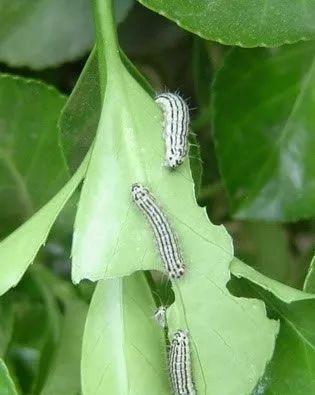01 Large-leaved boxwood long-haired moth

Main host plants:
Common hazards are macrophyllae, silk cottonwood, Fufang vine and other Plants of the Family Officinalis.
Hazard Dynamics:
The large-leaved boxwood spotted moth occurs in one generation a year, overwintering on the branches of the host plant with eggs, and hatching in the early spring of the following year. Its larvae have small heads, relatively hypertrophied carcasses, pale yellowish-green body color, black longitudinal lines, white slender hairs, hatching and clustering of 1-2 instar larvae endanger the young leaves of the shoots, disperse after 3 instars and the amount of food increases dramatically, often long enough to eat the leaves of the host plant in a short period of time.
Recently, monitoring has found that the insect is harmful to the accumulation of damage on the budding silk cottonwood, and the symptoms of the related host plants can be observed.
Prevention and control methods:
1. It is found that the young larvae clustered in the branches can be manually pruned and concentrated on extermination;
2. If the density of the insect mouth is high, the larvae can be sprayed with a knife flow (5% high performance cypermethrin microemulsion) 800 times liquid spray, and the damage can be dispersed (20% thiamethiasis • perchlorofluorine microcapsulation suspension) or crown (12% methioniae insect mite nitrile suspension) 800-1200 times liquid spray.
02 Tea Yellow Poison Moth
Host Plants:
It can harm tea, coral, heather, red leaf heather and other garden plants.
Tea yellow poison moth occurs 2 generations a year, overwintering with eggs, the first generation of larvae occurs generally from early April to mid-June, the larvae have clusters before the 3rd instar, often clustered in the branches to feed on the leaves, it is easier to find the damage on the shrubs, and the damage is dispersed after the 3rd instar, the amount of food is significantly increased, and the plant leaves can be eaten up in a short period of time.
At present, the larvae of the tea yellow poison moth have hatched and harmed. Poisonous moth larvae have poisonous hairs, which will cause strong skin tingling and rash after contact, and areas with frequent human flow activities should be paid special attention to, and related host plants can be observed, and if there is harm, it should be controlled in time.
1. In the case of a small number of larvae, the insect branches can be cut off before the larval cluster is dispersed;
03 months of season black spot disease
Host plants: moon, rose, yellow thorn rose and other roses, roses and other flowers of the genus Rose.
Hazard dynamics: Susceptible plant leaves, petioles, young branches, peduncles can be damaged, to the leaves are the most seriously affected, the initial leaf spots are brown dots, gradually expanded to black brown nearly round spots, the edges are blurred, sometimes the edges of the spots have a yellow halo, the disease can lead to a large number of leaves in the month, the normal growth of the moon and the ornamental effect have a greater impact.
There are two peaks of incidence of black spot disease in the monthly season, spring and autumn, and the disease develops rapidly with increased rain and humidity in spring. According to monitoring, at present, the leaves of the monthly season have begun to appear disease spots, which can be observed and prevented.
Prevention and control methods: Can be used Xianrui (40% pentazole • ether ester suspension), alzole (40% difenethicazole suspension), curl (25% isobacterium urea suspension) 800-1000 times liquid spray, 7-10 days spray once, spray 2-3 times, pay attention to the alternating use of the agent. Continuous observation is required after the end of one cycle and, if necessary, repeated medication.
Powdery mildew in April
Host plants: moon, rose, rose and other rose family, rose genus of a variety of flowers.
Hazard dynamics: can harm the whole plant of the month, the beginning of the disease at the top of the young leaves appear white powder, the diseased leaves roll back, wrinkled, stop growing, buds do not flower after infection or flower deformity, when the disease is serious, the whole plant monthly white powder, no flowering or deformed flowers, the growth and ornamentation of the month are greater.
Powdery mildew in the month has two peaks of occurrence in spring and autumn, and is currently in the spring disease occurrence period, according to observation, small pieces of white powder spots have appeared in the disease-sensing leaves, and the new shoots of the monthly young leaves are twisted and deformed, and the relevant symptoms can be observed and controlled in time.
Prevention and control methods: leaf wind (12% nitrile and triazolone emulsion), Xianrui (40% pentazole ether ester suspension) or 30% tetrafluoroetherzole acetophen sulfonate water emulsion 800-1200 times liquid spray, spray once in 7-10 days, spray 2-3 times, pay attention to the alternating use of the agent.
05 Heather powdery mildew
Host plants: heather, basswood heather
Hazard dynamics: Infecting heather new shoots and young leaves, white powder appears after the new shoots are diseased, twisted and deformed, unable to spread leaves normally, and the leaves change color and fall off in the later stage. Spring heather new leaves can be susceptible to disease, according to monitoring, the current heather powdery mildew in local areas has occurred, can pay attention to observation, timely control.
Warm reminder: The content of this platform is from the network If there is infringement, please inform us, we will deal with or revoke it at the first time; the Internet is a resource sharing ecosystem, we advocate sharing, let us spread positive energy together. If you like this article, don't forget to like, collect, forward, and also welcome to express your views in the comment area, welcome to pay attention to: Ye Crooked.